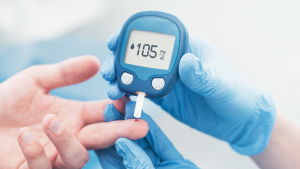It’s a miracle! Or is it? When it comes to weight loss, failed attempts and a scale’s yo-yoing can make you wonder. The off-label, often misguided use of medications like Ozempic may lead to seemingly miraculous results. But, at what cost? What is fact and what is fiction when it comes to Ozempic and similar drugs? And why is their recent status to weight-loss prominence as much a cautionary tale as a source of hope? (For me, emphasis is on the former.)

The debate over drugs and their off-label use wouldn’t even exist without some proven benefits. (And without Tik Tok!)
But no debate, it seems, is ever fully “resolved,” as pros and cons are rarely purely black or white. They spread across the gray scale (pun intended) in all applications: physical, psychological, medical, cultural, social, financial, ethical.
And the topics in the margin notes – side effects, long-term risks, and sustainability – are at the mercy of longitudinal studies. (Not what quick-fix hopefuls want to hear.)
Ozempic and other GLP-1 drugs are no different.
The accolades are countered by an equal number of “yeah-buts.” And everyone seems to have a strong opinion, despite any gray area that leaves the debate wide open.
The conversation, like Ozempic itself, goes off-label with topics like food noise, body image, and Body Positivity. (Proving, as always, that there is more to consider than what the hyped-up frenzy of ads want us to believe.)
But first, for those who can’t really hear the advertising jingles but haven’t really listened to the words…what exactly is Ozempic?
**Content warning (cw): please take care of yourself. The content below includes reference to people in large(r) bodies. If the topic of weight centric care in the “treatment” of higher weight people with medical problems is difficult or destabilizing, please skip it. Also, please note the word “obe*ity” will be written as “the O word” or as “obe*ity. Why? Because most of the research on weight and health assumes pathology, all based on body size. There is rarely consideration for social and systemic contributions.. Phrases such as “people of higher weight” or “people in large(r) bodies” separate the term “obese” from the person, helping emphasize the concept that body weight is just one factor that makes up the whole person and certainly not the most important thing about them.
The lack of consideration just reinforces the false narrative that correlation equals causation. To learn more about a weight-inclusive (versus a weight normative approach to health) start here.
Diabetes As A Starting Point

In order to understand the truth about Ozempic, we have to understand at least the basics of diabetes. That’s because Ozempic has its origins not in weight, per se, but in blood sugar levels.
It was developed (over 20 years ago) as a response to a chronic physical disease, not body-image or Diet Culture issues.
Type 1 diabetes
When a non-diabetic person eats a meal, β cells in the pancreas secrete the hormone insulin into the bloodstream. The insulin then causes glucose – now at a high(er) level from eating – to enter cells, where it is stored as energy.
Without insulin, blood glucose levels would remain elevated, leading to a bunch of problems.
Type 1 (juvenile, insulin-dependent) diabetes is a chronic autoimmune disease that destroys the pancreatic β cells that produce insulin. People with this disease produce little or no insulin and therefore need insulin provided from the outside. They couldn’t survive without it.

We probably know at least one person who has been insulin-dependent since childhood. Those with this disease are never far from their insulin, whether injectible or in an attached pump.
Achieving blood sugar balance, however, isn’t always so easy. The sudden surge of insulin often has the hyper-effect of causing blood sugar levels to plummet. That’s why people who have to inject insulin usually have some source of sugar on-hand: orange juice, chocolate, etc.

Survival for type 1 diabetics is a constant finessing between hyperglycemia and hypoglycemia.
Type 2 diabetes
Type 2 (adult-onset) diabetes is also a disease involving elevated blood glucose levels.
Unlike type 1, however, it usually starts with resistance to insulin. Blood glucose levels rise because the body’s cells resist insulin’s efforts to draw glucose into them.
The pancreas tries to combat the problem by making more insulin. But eventually, if left untreated, the body simply can’t keep up, and blood sugar levels rise.
You may have heard of type 2 diabetes in the context of metabolic syndrome. This is actually a cluster of conditions that can lead to heart disease and type 2 diabetes.
CW: fat stigmatizing word (obe*sity) ahead
Obes*ty, diabetes, and Ozempic
The unexpected subject of interest in the whole type 2 diabetes-Ozempic story?
Body weight…and, specifically, obes*ty.
Why?

Because being in a high(er) weight body or ob*se is thought to be one of the underlying risks leading to type 2 diabetes. And diabetes was the original inspiration for research that led to Ozempic and other GLP-1 drugs.
What Are Ozempic, Wegovy, and GLP-1 Agonist Drugs?
Insulin isn’t the only hormone involved in regulating blood sugar levels. But it is the only hormone that can directly decrease them.
At the risk of cliché, it takes a village to regulate blood sugar levels. While insulin may get the most soundbites, it doesn’t act alone.
What is GLP-1?
Another hormone, glucagon-like peptide-1 (GLP-1), is also involved in regulating blood sugar, appetite, and digestion. This metabolic hormone is produced in the gut and brain and has many functions.
Three standout functions of GLP-1 with regard to weight loss include:
- Stimulating insulin production/secretion and decreasing glucagon secretion when blood glucose levels are high.
- Slowing the rate at which food is released from the stomach (gastric emptying), thereby quickening and prolonging a sense of satiety.
- Reducing food intake (appetite suppression).
Sounds like something most of us would like more of, right?
Well, it’s that first function – stimulating insulin secretion and decreasing glucagon secretion – that inspired the conception of GLP-1 agonist drugs like Ozempic.
Remember, type 2 diabetes usually starts as insulin-resistance.
GLP-1, in effect, runs interference by stimulating the pancreas to produce more insulin and the body’s cells to be more sensitive to it.
It also inhibits glucagon from releasing more glucose into the bloodstream.
This mechanism was the driving force behind the development of Ozempic, its precursors, and its offspring. Scientists wanted to develop a drug that could regulate blood sugar levels without the extreme plummets often experienced with injected insulin.
How GLP-1 agonists came about
(The New York Times published an enlightening article in 2023 about the history of Ozempic and the weight-loss drugs inspired by it. The following is a brief summary to help readers understand the history of Ozempic and GLP-1 agonist drugs.)
Research into the role of GLP-1 in regulating blood sugar levels led to the development of an injected version for use with diabetes. The problem, however, was its short duration and inability to reach the pancreas in time to stimulate production of needed insulin.

Fast forward to Gila monster saliva (seriously) and the discovery of a more durable variant of GLP-1. But twice-daily injections were still too much to be incentivizing.
Novo Nordisk, a pharmaceutical company primarily devoted to diabetes research and intervention, found a way to cut the dosing frequency in half. Its daily-injectable liraglutide (Victoza) was approved as a diabetes treatment in 2010.
And here’s where the connection to weight loss was first noticed. Not only were subjects regulating their blood sugar levels; they were losing weight. Not much, but they were losing it.
So, in 2014, Novo Nordisk released the same drug – but at double the diabetes dose – for weight loss under the name Saxenda.
Diabetes or weight loss? Pick one, not both
Up until this time, obes*ty had been viewed and treated as a lifestyle issue. Diet mismanagement, lack of willpower, preventable self-infliction of metabolic syndrome and diabetic symptoms. (NOPE!)

There may be lifestyle factors involved in obe*ity. But there are also a lot of other factors, including internalized weight stigma, genetics, stress, privilege, and medications. Hormonal imbalances, sleep-deprivation, and environmental and socioeconomic influences also contribute.
And obe*ity is thought to be associated with heart disease, stroke, diabetes, osteoarthritis, joint pain, and even cancer. (It may, however, be the effects of weight discrimination and Diet Culture that account for the correlation between obe*ity and poor health. There has never ever ever been a properly designed research study ‘proving’ that the “o word” is what causes poor health outcomes.)
It’s easy to see how the effects of obes*ty can be assumed to create a self-perpetuating cycle of poor health and well-being.
It’s also easy to see why there would be motivation to create a pharmaceutical intervention for both diabetes and obes*ty.
So fast forward again, and Novo Nordisk, still prioritizing diabetes and not weight loss, released semaglutide (Ozempic) in 2017.
Its big perk? Weekly vs. daily injection frequency, i.e. a longer-lasting GLP-1 drug. Just what the company was trying to achieve.
Oh, and as an after-the-fact observation: weight loss. Literally three times the weight loss experienced with the daily injectible – a data point still not understood.
Suddenly diabetes wasn’t the only motivating condition. Weight loss was, too. They couldn’t ignore it.
And they were thinking that they shouldn’t.
Enter Wegovy
The general public may say “Ozempic” and “Wegovy” in the same breath. Understandable. But here’s where the FDA and marketing create “technicalities”:
Novo Nordisk had developed Ozempic for use with diabetes. The weight-loss side effect was just that: a side effect. The drug therefore couldn’t be marketed as a weight-loss drug.
How did the pharmaceutical company get around that challenge to maximize applicability and profits in two separate but related markets?
First, its advertising mentioned that many patients lost weight on the drug.

How many people need to hear more than that to jump on the bandwagon?
As you can imagine, patients and doctors alike pushed the envelope of Ozempic’s intended use. And they quickly launched it into the pharmacy of public opinion as a weight-loss drug.
Ozempic became an off-label craze, to the point where demand exceeded supply.
Seeing and seizing the opportunity to market a drug with weight-loss as its primary function, the company took the next step. And, in 2021, the FDA approved release of the same drug at a much higher maximum dose of semaglutide.
Enter Wegovy.
The key to Ozempic and Wegovy’s weight-loss effectiveness

So much about these GLP-1 agonist drugs remains a mystery, even to the scientists who developed them. Of course, the complexity of the body’s own regulatory circuits presents its own confounding mysteries that can’t be ignored.
However, the crux of the drugs’ power undoubtedly lies in this fact:
The brain is being exposed to levels of the hormone GLP-1 not seen in nature. The agonist drug isn’t replacing non-existent or deficient levels of GLP-1; it’s flooding the brain and body to maximize its weight-loss effect. And the jury is still out on how that exposure will play out longitudinally.
Pros and Cons of Ozempic and the GLP-1 Agonist Drugs
The inescapable hype of GLP-1 drugs
The advertising is so frequent and irritatingly catchy that it borders on subliminal. Just the way Big Pharma wants it. After all, they have to get you all buttered up with the “pros” before they speed-read through the “cons.”

“O-o-o-O-ZEM-pic!” The jingle overlies visual clips of everyday people doing everyday things with not-so-everyday exuberance.
In their defense, they are entering the “Ozempic Tri-Zone”: lowering A1C, CV risk, and weight. What could possibly make a person happier? (And who the heck knows what A1C is, anyway? It just makes the song easy to sing: “I’m low-er-ING my-y A1C-eee….”)
First, the lyrical listing of potential benefits.
The truth about Ozempic is that it’s FDA-approved for type 2 diabetes, not weight loss.

But that doesn’t mean the commercial isn’t going to mention that you might lose weight: “Oh, by the way, adults lost up to 14 pounds.”

Operative words: “up to.”
Then come the precautions, both spoken in a low, speedy rumble and written fine-print-style across the bottom of the screen. “Ozempic isn’t for people with type 1 diabetes. Don’t take if you or your family ever had medullary thyroid cancer. Stop if you notice a lump or swelling in your neck…nausea…diarrhea…gall bladder problems…blurry vision….”
Typical pharmaceutical advertising.
But here’s the big-picture message of all the hyped-up advertising: Every medication has pros and cons. Yes, the pharmaceutical company hopes its drug will help people. (Sometimes even that’s questionable.)

But it’s also trying to sell you something. So do your homework and consult an appropriate medical expert if you think you might be a good candidate for the drug.
And listen carefully to the way things are worded. Every word, phrase, visual, musical note, and transition is intentionally, carefully chosen.
Below are lists of pros and cons of GLP-1 drugs like Ozempic, Wegovy, and Mounjaro. The lists are not complete, but should give you a basis for understanding benefits and risks.
Pros of Ozempic and other GLP-1 drugs
- Increased insulin production and secretion in response to high blood-sugar levels
- Reduced glucagon
- Lower A1C values
- Slowed gastric emptying
- Faster and more prolonged satiety
- Lower food-noise volume
- Decreased appetite
- Weight loss (sometimes 15-20%)
- Improved liver function
- Lower rates of stroke, kidney disease, and heart disease
- Up to 20% reduction in heart attacks, strokes, and death by cardiovascular disease
Cons of Ozempic and other GLP-1 drugs
- Nausea
- Abdominal discomfort
- Vomiting
- Diarrhea
- Pancreatitis
- Inability to tolerate liquids and solid foods
- Increased risk of thyroid cancer with prolonged use
- Complications with sedation
- Risk of weight returning if the medication is stopped without lifestyle modifications in place
- Muscle loss
- High cost – sometimes $900-1400 per month without insurance
- Worsening of conditions like disordered eating and eating disorders
- Triggering of body image issues
- Risk of depression and anxiety if the medication is stopped and weight returns
- Scientists and doctors still don’t fully understand how the drugs work, especially in the brain
Miracle or Not?
So we’ve come full circle. And, we’ve come back to the starting point with a lot more information.


So the question remains: Is Ozempic a miracle drug or something to be avoided?
The truth about Ozempic (and other GLP-1 drugs like Wegovy) is that it’s nowhere near “perfect.” Nothing ever is. Everything has a trade-off of benefits and side effects.
Only you and your doctor (who by the way is likely biased in favor of GLP-1 drug use) can effectively evaluate your health and its array of genetic and lifestyle influencers.
For some, drugs like Ozempic may give enough agency over their type 2 diabetes that they can make other changes.
A 10-pound weight loss may have benefits to a person’s overall health, for example. And, if a medication can help make that happen, exercise may become less painful. A great boost to lifestyle.
On the other hand, the negative aspects of the GLP-1 agonist drugs may outweigh the positive aspects for some people. They could exacerbate risks that aren’t likely to be minimized by weight loss (or even diabetes control) alone.
We will be breaking down the hype of Ozempic and other weight-loss drugs in future articles.
Until then, suffice is to say that semaglutide and similar drugs are having a big impact on diabetes control. And, that can be the difference between life and death.
Also worth noting is the unexpected hope of potential benefit to other life-threatening conditions and chronic diseases.
If for no other reason, that warrants both our attention and caution.
Dr. Elayne Daniels is an international coach, consultant, and psychologist specializing in eating disorders, body image, and High Sensitivity. She is anti-diet, Intuitive Eating certified and passionately believes comfort in your body at any size is your birthright. Contact her here for more information.
